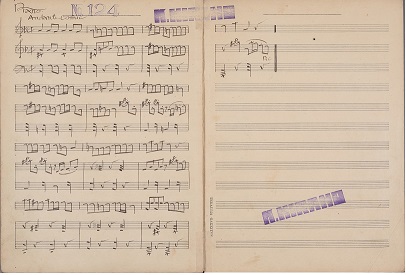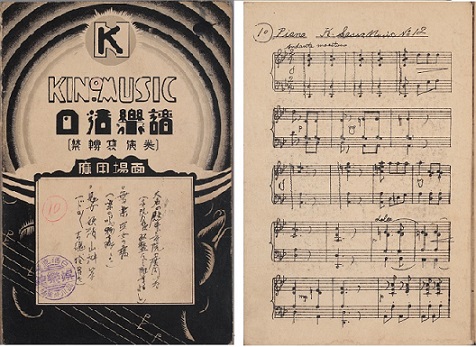Selected research project 2: Research on materials related to the presentation of silent films, and particularly their musical accompaniment
-
Principal Researcher: Seiji Choki (Professor, Graduate School of Arts and Sciences, the University of Tokyo)
Collaborative Researchers: Makiko Kamiya (Adjunct Researcher, the Theatre Museum, Waseda University), Fumito Shirai (Doctoral Program, Graduate School of Arts and Sciences, the University of Tokyo), Yohei Yamagami (Part-time Lecturer, Faculty of Music, Tokyo University of the Arts)
【Research objective】
The topic of this research is the Theatre Museum’s collection of musical scores, used to accompany silent films; its objective is to clarify how silent films were presented from the Taisho era to the beginning of the Showa era, with a particular focus on their musical accompaniment.
One feature of this research is that it employs the knowledge and methodologies of musicology, including detailed analyses of the musical scores and comparisons with recordings. The researchers are taking an inventory of the materials, creating a database, transcribing the manuscripts, and then comparing them to published musical scores, as well as collecting and examining related documents. Through this approach, they aim to reconstruct the way films were presented at that time, and to explain how the music and images were combined.
【Summary of the research findings】
The investigation has mainly been conducted by the researchers Shirai and Kamiya and the research collaborator Shibata Kotaro (Doctoral Program, Graduate School of Humanities and Sociology, University of Tokyo), who have provided an overview of the materials. These materials are a collection of musical scores that were used to provide musical accompaniment for silent films from the middle of the 1920s to the start of the 1930s. From the signatures and seals indicating ownership, it is believed that they are parts of the scores used at the film theatre, “Goraku-kan” in Shinagawa, Tokyo. This theatre was directly managed by the Nikkatsu Corporation, and the scores were mainly used by a person named Hirano. As materials were numbered, in accordance with their condition at the start of the investigation (they had been kept in 2 cardboard boxes and a total of 14 bags), we now know that there are in excess of 600 items. Their content has been broadly categorized as follows:
① An untitled collection of hand-written music for a small, accompanying orchestra; this includes approximately 120 musical pieces (stamped with the seal of K. HIRANO)
② "Kino Music Nikkatsu Gakufu,” unpublished musical accompaniment: 33 pieces of music written for a small orchestra
③ “Small Orchestra,” domestically-published musical accompaniment: 25 pieces of music written for a small orchestra (Tokyo Small Orchestra Score Association, 1924)
④ “Cinema Inc. Series,” “Berg’s Inc. Series,” musical accompaniment published in the United States: 110 pieces written for a small orchestra (Belwin Inc., thought to have been published in the second half of the 1910s)
⑤ Other materials (infrequently used parts, solo-part scores with the name of the film written on them, several cue sheets, etc.)
According to an interview with a specialist in domestic archives, this is the first discovery within Japan of a collection of musical scores for the musical accompaniment in use at that time. The analysis of the content of each of the collections is being carried out in parallel with the preparation of a temporary inventory. It has been found that the collections include many works by composers mentioned in contemporary discourses, such as Koka Sassa and Nobuhiro Matsudaira. Moreover, the collection published by Belwin, Inc. (④) is one of the main collections of musical accompaniment used in the United States at that time, and has shed light on the extent to which Japanese practices were connected to those overseas. Also, an analysis of the different instrumental parts (such as the piano parts missing from the scores discussed in previous research), the combination of Japanese and Western characteristics in relation to harmonies and musical instrument settings are being examined.
One future task will be to realign these musical pieces with their film images. At present, in addition to analyzing materials that include examples of musical accompaniment for particular scenes, the name of the film on several cue sheets, and the Nikkatsu Gakufu(②), researchers are also inspecting related film pieces and collecting and analyzing materials, such as the weekly reports of the Shinagawa Gorakukan and pamphlets.


